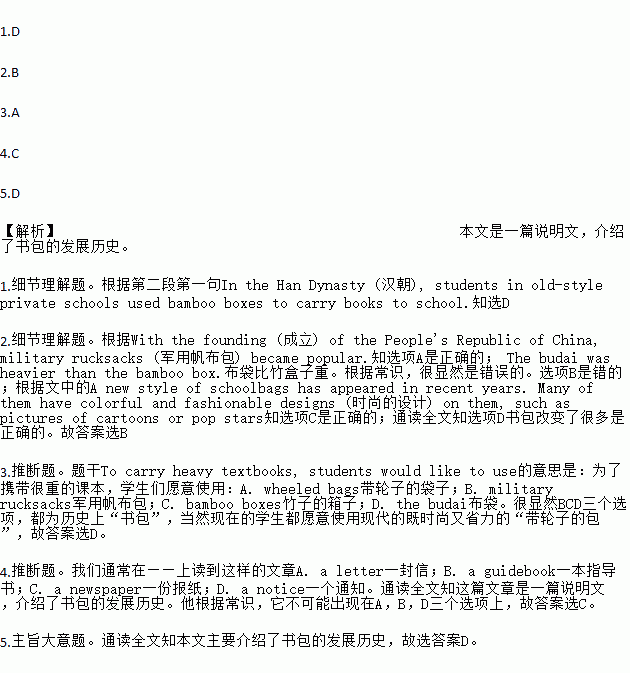题目内容
Every school day, we use schoolbags to carry all of our things to school. They are a big part of our lives. But have you ever thought about the history of the schoolbag?
In the Han Dynasty (汉朝), students in old-style private schools used bamboo boxes to carry books to school. People consider the bamboo boxes to be the earliest schoolbags. They were usually two or three layers (层) in the box. Kids put different things like books, brushes, ink stones (砚) and paper in the boxes.
Hundreds of years later, people developed a new kind of schoolbag called the budai, or the "hip-pocket". The budai was lighter than the bamboo box. With the founding (成立) of the People's Republic of China, military rucksacks (军用帆布包) became popular. Many people carried them when they were in school. Ask your grandparents or parents about these bags. Maybe they can tell you about their experiences of carrying them when they were in school.
A new style of schoolbags has appeared in recent years. Many of them have colorful and fashionable designs (时尚的设计) on them, such as pictures of cartoons or pop stars. And they are more comfortable to use. Some students pull wheeled bags filled with heavy textbooks and others carry backpacks.
Schoolbags are still changing. Can you imagine what future schoolbags will be like?
1.Schoolbags in the Han Dynasty were made of _______.
A. cloth
B. paper
C. plastic
D. bamboo
2.Which is NOT true according to the passage?
A. Military rucksacks were popular in the 1950s.
B. The budai was heavier than the bamboo box.
C. There are some pictures on the new style of schoolbags.
D. Schoolbags have changed a lot.
3.To carry heavy textbooks, students would like to use _______.
A. wheeled bags
B. military rucksacks
C. bamboo boxes
D. the budai
4.We can usually read the article in ________.
A. a letter
B. a guidebook
C. a newspaper
D. a notice
5.The purpose of the article is ______.
A. to tell us how to use schoolbags
B. to explain why we use schoolbags
C. to introduce the importance of schoolbags
D. to introduce the development of schoolbags
 同步练习强化拓展系列答案
同步练习强化拓展系列答案书面表达
86.目前有不少历史剧在电视上热播.有人通过看历史剧来了解历史,有人选择读史书来了解历史,你选择哪种方法?理由是什么?请你根据以下内容写一篇英语短文。
方法 | 理由 |
看历史剧 | 情节有趣、通俗易懂; |
读历史书 | 资料真实、引人深思; |
……(你的选择) | ……(你的理由) |
要求:
(1)词数:80~100个。
(2)开头已给出,不计入总词数。
(3)要点齐全,行文连贯,可适当发挥。
Many historical plays have been on TV recently.________________________________________________
Has anyone told you that it’s fun to play with English words? For a long time these “words within words” in English have been used to surprise and educate us…and they often make us laugh too. Now we go to learn about them.
Riddles(谜语) How did the animals open the zoo door? They used a monkey! What’s the longest word in English? Smiles—there’s a “mile” between the first and last letters! These jokes —a question followed by a surprising answer — are known as “riddles”. But the ones above are examples of a special kind of riddle, a riddle which is funny because a word is hidden within another word. Many English speakers are crazy about this kind of words with double meaning. And it can be found in texts written in English a very long time ago. But riddles are not the only example of “words within words”. |
Hidden words During Victorian times (1837—1901), the game of hiding words within a whole sentence became popular. Look carefully at this sentence—The king eats his lunch in a fine palace. Can you see that the countries “China” and “Nepal” are hidden in it? The Victorians even used hidden words to teach children history and geography at school. Today we still see hidden word games in books and magazines, but we also use hidden words in jokes. |
Palindromes(回文词) Palindromes are words and phrases which can be read the same forwards and backwards. The pop group “Abba”, for example, is a palindrome. The sentence “Was it a car or a cat I saw?” is also a palindrome. We find them interesting, but they can also be funny: I kept receiving emails about reading maps backwards, but then I realized it was just spam(垃圾邮件)! |
1.Which of the following is a riddle?
A. step—pets, part—trap B. hiding words within a whole sentence
C. silent—listen, the eyes—they see D. Which letter is a question? Y (Why) .
2.By reading the article we can know “___________”.
A. Riddles are the only example of “words within words”.
B. Victorians even used riddles to teach kids history at school.
C. “Was it a car or a cat I saw?” is a palindrome as well.
D. These “words within words” in English often make us cry.
3.The best title of the passage is ________.
A. It’s fun to play with words B. “Words within words” educate us
C. Riddles & Hidden words D. The pop group “Abba”

